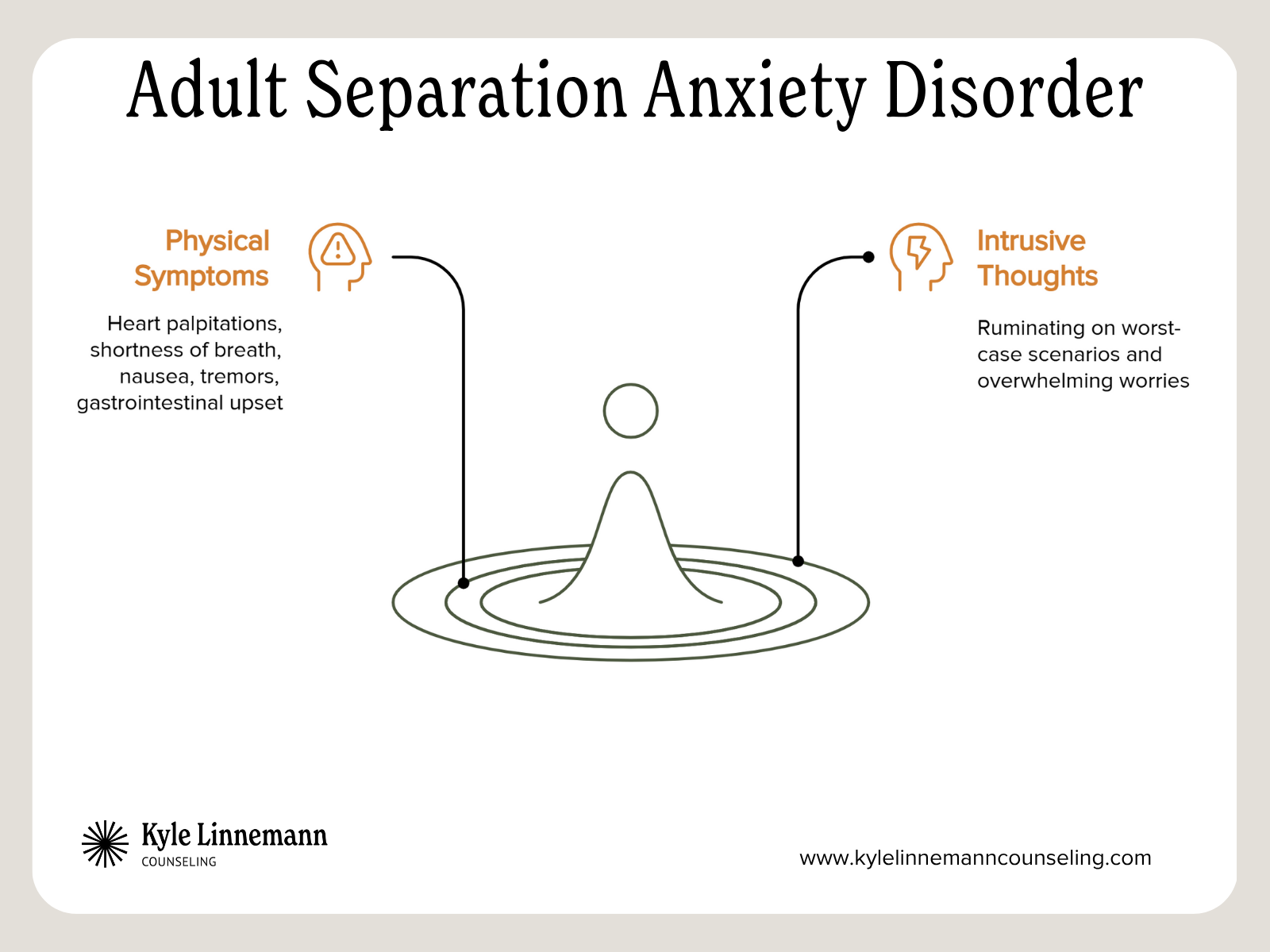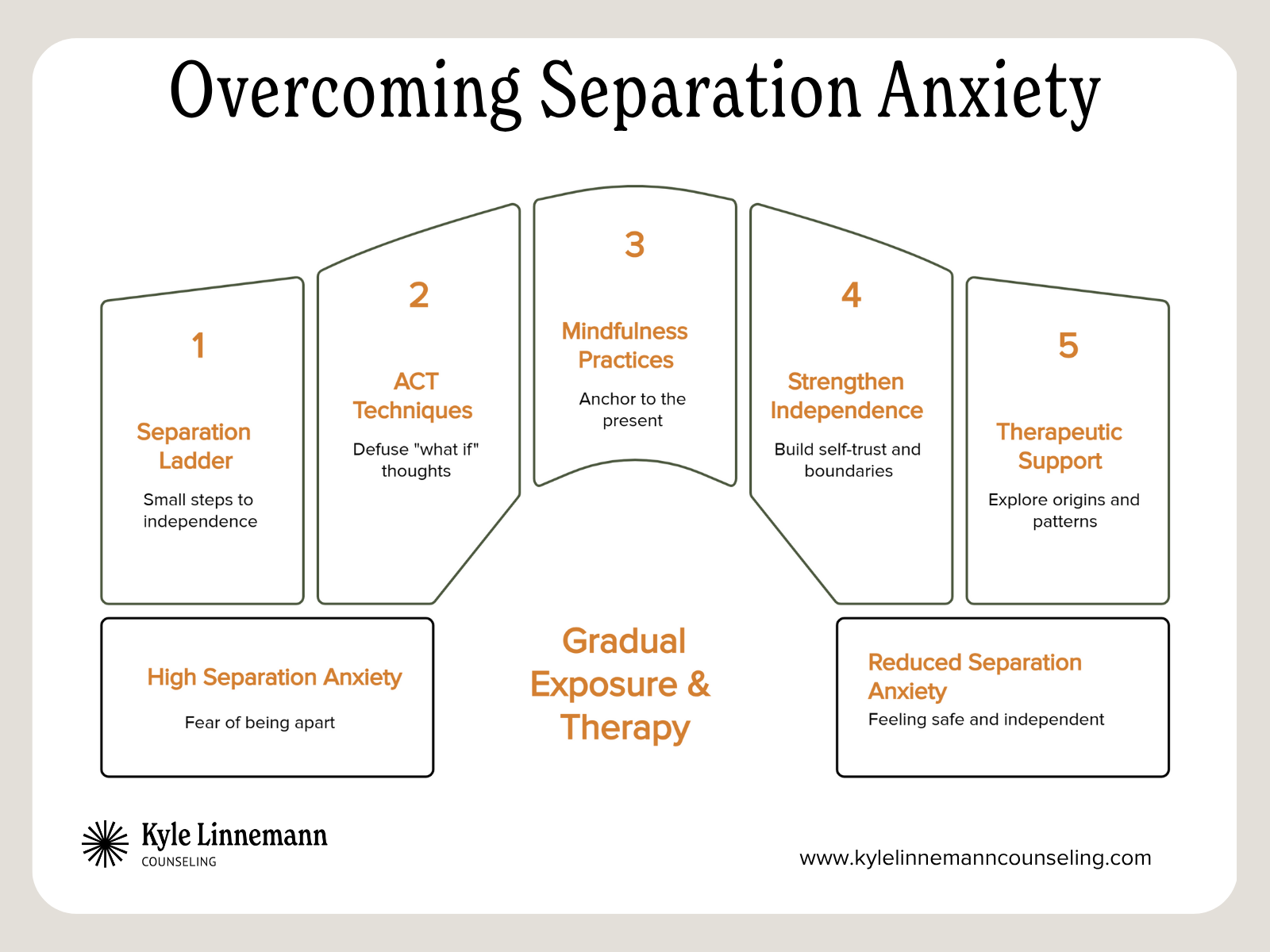Why Separation Anxiety in Adults Happens And How to Cope
Maybe when you and your loved one are apart, your chest tightens, your mind races, and even simple errands feel like a threat. What you’re feeling may be more than just worry or missing someone; it could be adult separation anxiety disorder.
In this article, I’ll walk you through separation anxiety in adults: what it is, how it often develops, and how it shows up in daily life (including physical and emotional anxiety symptoms). Then, I’ll share evidence-based ways you can cope and gradually reclaim more ease and freedom.
Here’s our roadmap:
What is separation anxiety in adults (vs. childhood separation anxiety)
Causes & contributing factors
How to cope with separation anxiety: practical strategies
When to seek help + what to expect
If you’re ready, let’s dive in, and if at any point you want a guiding hand, I’ll show you the next steps.
What Is Adult Separation Anxiety — Beyond Childhood Myths
You might tell yourself it’s “just missing someone” or normal worry, but separation anxiety in adults is something deeper and more persistent. It’s more than longing. It’s an anxiety disorder where separation triggers excessive fear, distress, and physical symptoms, even when the separation is expected or temporary.
Persistent, Distressing, and More Than “Missing Someone”
In everyday life, everyone feels nervous or uneasy at times when apart from a close person. But adult separation anxiety disorder goes beyond that. The distress is intense, chronic, and disrupts your life. You may experience physical symptoms like:
heart palpitations
shortness of breath
nausea
tremors
gastrointestinal upset
You might ruminate on worst-case “what ifs” (e.g. “What if something happens to them?”) in a way that’s intrusive and overwhelming.
Unlike transient anxiety or the fleeting pangs of missing someone, this is often comorbid with other anxiety conditions, such as panic disorder, generalized anxiety disorder, or social anxiety disorder, and may amplify or be amplified by them. Many adults with separation anxiety also present with depression or other mental health conditions.
How Adult Separation Anxiety Differs from Childhood Separation Anxiety
For years, separation anxiety was thought of as a childhood disorder, a developmental phase where young children fret when separated from caregivers. In the DSM-IV, onset before age 18 was often a required assumption. But in the newer Diagnostic and Statistical Manual of Mental Disorders (DSM-5), the age restriction was removed, recognizing that separation anxiety disorder may first appear or persist into adulthood.
Indeed, research suggests that the majority of adults with separation anxiety symptoms developed them in adulthood (rather than carrying them over untreated from childhood).
Still, the childhood form and adult form share features: fear of separation from attachment figures, excessive worry about harm to them, avoidance behaviors, and physical symptoms.
Key Diagnostic or Threshold Elements
To diagnose separation anxiety in adults, several criteria or thresholds are important:
Duration: Symptoms must persist (often six months or more in adults) rather than being short-lived.
Intensity & Impairment: It’s not just discomfort; it causes significant distress or interference in core areas—work, relationships, social life.
Number of symptoms: The DSM-5 lists multiple possible separation anxiety symptoms (worry about losing a loved one, reluctance to be alone, repeated checking, nightmares, etc.), and a threshold (often at least three) must be met.
Not better explained by another condition: The anxiety must not be fully accounted for by OCD, illness anxiety, agoraphobia, or other disorders.
In short: adult separation anxiety is a real type of anxiety disorder, not simply nostalgia or “being too close to someone.” It’s persistent, intense, and often overlooked, but it can be diagnosed and treated.
How can I start coping with separation anxiety?
Start small. Practice short, safe separations, use grounding or breathing techniques when anxiety rises, and question those “what if” thoughts that predict the worst.
What Causes Separation Anxiety in Adults
Understanding what fuels separation anxiety in adulthood can help you make sense of your reactions and begin to change them. Here are some of the most common roots I see in therapy.
Attachment History & Insecure Bonds
The way we connected (or didn’t) with caregivers early in life shapes how safe we feel in relationships now. When emotional responses were inconsistent or unpredictable, separation can feel threatening later on. Studies show that anxious or ambivalent attachment styles are linked with higher separation anxiety symptoms in both children and adults.
Past Losses, Transitions & Traumas
Major changes, like the death of a loved one, a breakup, or moving homes, can leave emotional imprints that make future separations harder to handle. Research links early parental loss with higher adult separation anxiety and more anxious attachment later in life.
Genetic, Biochemical & Temperamental Factors
Sometimes biology plays a role. Genetic predispositions and neurochemical imbalances (especially involving serotonin and stress systems) can heighten vulnerability to anxiety. People with naturally high sensitivity or emotional reactivity may be more likely to experience separation anxiety.
Reinforcement & Fear Learning
Avoidance feels safe, but it teaches your brain that separation equals danger. Staying constantly close, over-checking, or seeking reassurance may soothe in the short term but strengthen separation anxiety disorder symptoms over time. Gradual, supported exposure helps retrain the nervous system to tolerate distance.
Co-Occurring Mental Health Conditions
Separation anxiety often overlaps with other anxiety disorders like panic disorder, OCD, or generalized anxiety disorder. Up to 66% of adults with panic disorder also meet criteria for adult separation anxiety disorder, showing how closely these conditions can intertwine.
Is separation anxiety normal in adults?
Yes. While it’s common in children, adult separation anxiety is also recognized in the Diagnostic and Statistical Manual of Mental Disorders (DSM-5).
How to Cope With Separation Anxiety Disorder — 5 Practical, Deep Strategies
Separation anxiety in adults can feel exhausting, even isolating, but it’s also highly treatable. When you understand what’s driving your fear and anxiety, and start using small, intentional tools to manage it, the world begins to feel bigger and safer again.
Gradual Exposure & Safe Separation Practice
Why it works: Exposure is among the most evidence-supported interventions for anxiety disorders, helping rewire fear responses.
How to start: Build a “separation ladder” — small steps like leaving the room for 5 minutes, then going on a short solo errand, etc.
Track & scale: Keep a log of each exposure (what you felt, how intense, what helped), and gradually increase exposure when your anxiety lessens.
Acceptance and Commitment Therapy: Working with “What If” Thoughts
Why it matters: Our minds love to predict danger, especially when we care deeply about someone. ACT (Acceptance and Commitment Therapy) helps us notice these “what if” thoughts without getting pulled into them. Instead of fighting the worry, we practice stepping back and choosing how to respond.
Technique: When a “what if” thought shows up (like “What if they get hurt?”), pause and label it for what it is: a thought, not a fact. Try saying, “I’m noticing I’m having the thought that…” This ACT skill, called defusion, creates space between you and the worry, so it feels less consuming.
Tools: Combine defusion with mindfulness (staying present with what’s actually happening) and values-based action (doing what matters even when anxiety is present).
Mindfulness, Grounding & Self-Soothing Skills
Why it helps: When anxiety surges, anchoring to the present moment neutralizes runaway worry.
Practices: Simple breath work, a 1-minute body scan, grounding via senses (what you see, hear, feel), or naming safe things in your surroundings.
Long-term payoff: Strengthens your emotional “container”; you begin to feel safer within yourself even when apart.
Strengthening Internal Security & Emotional Independence
Why it matters: When your sense of safety depends heavily on others, separation feels threatening.
Strategies: Identify your personal values, passions, or “you projects” that don’t hinge on someone else.
Boundaries & self-trust: Practice saying “I’ll do this alone” (even small things). Celebrate when you follow through; each win builds confidence.
Therapeutic Support & Relational Work
Why therapy is often essential: Separation anxiety often isn’t just a surface problem—you and I (as therapist) can go deeper into origins and patterns you can’t fully see alone.
Effective modalities: exposure therapy, ACT, attachment-informed therapy, or couples / relational therapy.
Relational repair: Sometimes the separation dynamics live in how we relate. Exploring these in therapy (or couples work) helps heal the fear loops.
Remember, treatment for adult separation anxiety isn’t about getting rid of your feelings; it’s about learning to manage your symptoms, build internal security, and trust that you can be okay even when apart. Whether that happens through gradual exposure, mindfulness, or working with a therapist, every step you take helps your nervous system learn a new truth: distance doesn’t have to mean danger.
How do people act when they have separation anxiety?
People with separation anxiety often worry excessively about loved ones, avoid being alone, or feel physical symptoms like chest tightness or nausea when separated.
When to Seek Professional Help (and What to Expect)
If your separation anxiety has begun to shape your days, dictating what you do, how you feel, or how you connect, it may be time to reach out for help. Separation anxiety disorder in adults is common but often underrecognized.
Signs It’s More Than “Just Anxiety”
You might benefit from professional treatment if you:
Avoid work, travel, or social plans because of anxiety about being away
Feel persistent physical symptoms of anxiety (tight chest, stomach upset, racing thoughts) when separated
Constantly check in or seek reassurance to feel safe
Notice that your daily life and relationships are shrinking around your fears
What Therapy Typically Looks Like
Therapy gives you a safe space to unpack the symptoms and causes behind the fear and to rebuild trust in your own stability.
Assessment & diagnosis: A therapist will explore your history, attachment patterns, and symptoms of separation anxiety disorder to understand the full picture.
Treatment plan: Together, you’ll create goals using evidence-based treatment options like psychoeducation, ACT, or exposure therapy.
Homework & growth: You’ll practice skills between sessions to help you manage your anxiety and increase confidence being apart.
Progress in waves: Healing isn’t linear. Some weeks feel light and freeing; others stir deeper layers, but both are progress.
With the right anxiety treatment and support, individuals with separation anxiety can gradually overcome separation anxiety, rebuild confidence, and move through life with more ease and independence.
A Safe Place to Work Through Anxiety and Feel Whole Again
If you’re reading this and wondering whether you deserve support, you do, and I’d be honored to walk with you. I offer a warm, nonjudgmental space where we’ll look at what’s driving your anxiety and separation anxiety symptoms, and create a plan that fits your life. Together, we’ll use evidence-based tools and steady, collaborative work to help you feel more secure and in control.
Schedule a free intro call anytime. I’ll meet you right where you are, and we’ll take the next step together.



